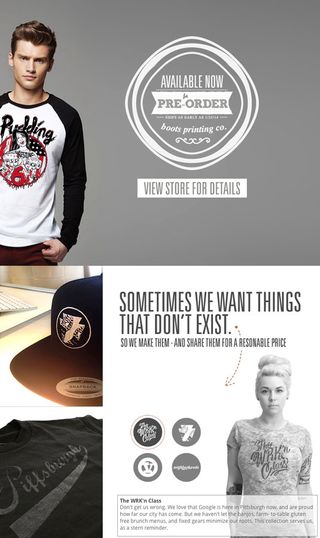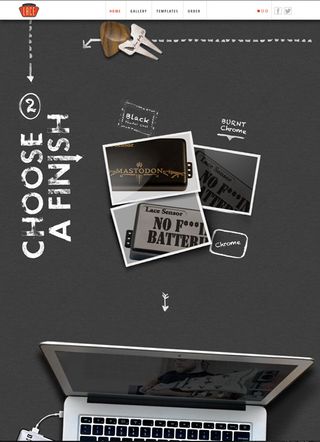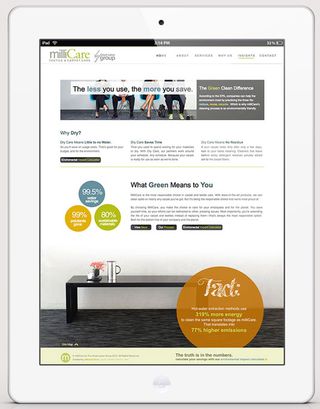
If you ever needed evidence that the next generation of web design tools are opening up site creation to a new constituency, then Christopher Watson is living, breathing proof.
In the last years he's carved out a successful new career in web design. But his route into the industry has been far from conventional. "About five years ago, I was a full time musician, a hired gun," he explains. "I'd play guitar and bass, mostly punk-rock oriented stuff. I spent a lot of time on a van - and had plenty of time to explore my first 'handed-down' version of Photoshop."
Escaping the van
"I had no idea people made a living doing design work," he admits. "But then suddenly people were like: 'Oh, would you design us some T-shirts?', or some other merchandising. "I thought: this is great. I'd found an alternate creative outlet outside of rock 'n' roll and spending the rest of my life riding in van or bus. I was eager to pursue a career in the design industry."
Initially, he focused on print design. "I'd always liked interactive design but was intimidated by development and didn't have the means to put it out there in the real world," he says. Then one day he was clicking around Adobe Updates and saw Muse come up. "I thought: 'I'll give it a shot.'"
It turned out to be a big catalyst in Watson beginning to design for the web. "Right away I was so excited that I could make a living breathing website, so I started using it to publish right away."
Client work
"Muse meant I could mock up my designs and see them work," he adds. "You know, they might look great on screen but until you see like the sun reflect uncomfortably on a mobile device, you don't really know.
"You need to be forced to realise: 'That's not reinforcing my call to action, like I thought it would when it was in Photoshop' - and then go back to the drawing board. That's what gives you a great opportunity to create stronger, more interactive designs."

He's been using the software for about three years, and a good example of his client work is BootsPrinting.com, which makes great use of video backgrounds.
"I spend a lot of time looking through award-winning websites to see where people are pushing the boundaries of design and development," Watson says. "And within a lot of expensive car websites I noticed highly interactive film element to it - something that's really polished looking - and I wanted to try and achieve that."
Budget beater
It may sound surprising that clients are willing to pay for work created with Muse, but Watson says it hasn't been an issue.
"Working with a lot of young startup businesses, they're not as concerned with the vehicle as they are with the end result," he states. "And they give you that creative freedom. So if I can deliver what they're looking for and keep the budget low, they're always happy to hear it.

"Not everybody has that 10K to 6-figure digital budget, so what are you going to do? I still want to deliver a highly polished website regardless of what a client's budget is."
Watson admits, though, that there's some resistance to this idea from elsewhere in the web developer community. "In the development world there's always going to be a best practice conversation, which I appreciate - and it's why I see development in general as an art form of its own," he says. "I have the upmost respect for developers as they are the ones setting standards that gives us the designers opportunities to create a more engaging experience."
But he thinks the industry is changing, and points to a parallel in what's happened in the music industry.
History repeating itself
"Decades ago when you cut a record it was analogue," he says. "Recording engineers dedicated their lives to perfecting the craft of sitting in the studio and physically cutting two-inch tape to make edits. But then things like Pro Tools came emerged and people were able to go down into their basement with their friends. It didn't take that high level of dedication to record an album any more.
"There was a lot of frustration from old-school engineers - I think that they felt their craft was becoming cheapened. And to their point, at first there was a lot of quality lost in digital recording. But over time digital recording's become better and better and it requires a sharp ear to tell the difference.

"I kind of see these new web tools doing the same thing. At first there was a lot of controversy. But just seeing the progress, of how aggressively Muse has been making updates and adding features, I see these tools as being extremely competitive."
Keeping it creative
That said, Watson cautions that any tool is only as good as the designer using them. "When dragging and dropping your images and making interactive buttons is so easy, it's real easy to overdesign and make a complete mess of things," he points out. "So you need to have a solid concept. Get your inspiration from the real world. Take a walk, go to the dog park. Get it down on paper."
Then once you've nailed your concept, there's nothing stopping you. "We have the freedom to experiment with UX when using applications like Muse. It's not like we're paying thousands of dollars for a developer and then it's a case of 'Well, there's no turning back now, it is what it is.'
"So don't be afraid to export your PSD as one big honking jpeg. Drop it in there and look at it on your desktop and mobile devices. And if its still as compelling as it was in Photoshop, then build it."

Thank you for reading 5 articles this month* Join now for unlimited access
Enjoy your first month for just £1 / $1 / €1
*Read 5 free articles per month without a subscription

Join now for unlimited access
Try first month for just £1 / $1 / €1
Get the Creative Bloq Newsletter
Daily design news, reviews, how-tos and more, as picked by the editors.

Tom May is an award-winning journalist and editor specialising in design, photography and technology. Author of the Amazon #1 bestseller Great TED Talks: Creativity, published by Pavilion Books, Tom was previously editor of Professional Photography magazine, associate editor at Creative Bloq, and deputy editor at net magazine. Today, he is a regular contributor to Creative Bloq and its sister sites Digital Camera World, T3.com and Tech Radar. He also writes for Creative Boom and works on content marketing projects.